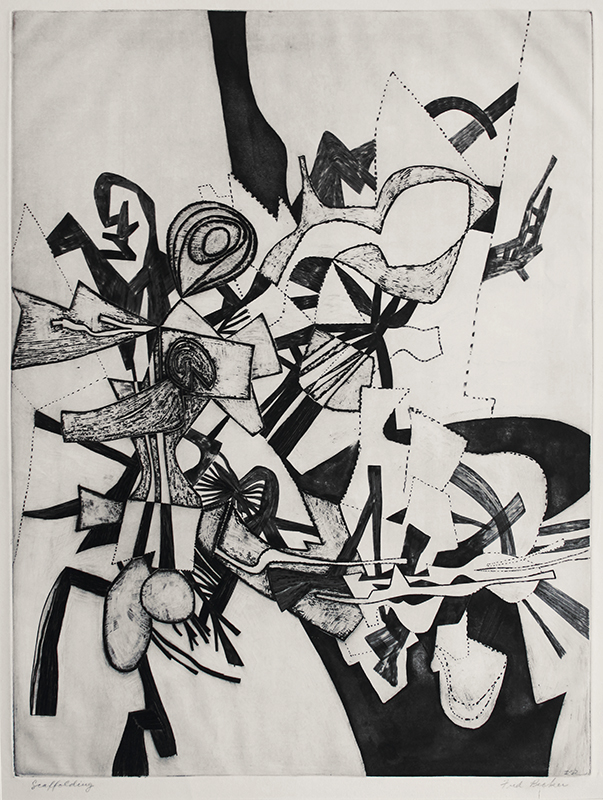Scaffolding is an intaglio created in 1952 by Fred Becker. It is pencil signed and dated and is proof from an edition of ten or fewer impressions. Scaffolding was printed by the artist on cream wove paper and the platemark measures 23-3/4 x 18 inches.
To produce this intaglio, Becker used open-bite etching and engraving, both by hand and using a multiple lining tool and a chisel. Becker worked out most of his compositions on the plate rather than working from sketches. In George McCue’s 1957 article “Evolution of a Printmaker: Work of Fred Becker Receives New Recognition” he quoted Becker: “What I like most about printmaking is the impersonal transposition of the image which is inked and then pressed against something else. I can take a copper plate and work on it for a long time, but what results is not like a drawing that you do a lot of work on but something that has a kind on newborn freshness.”
Frederick G. Becker was born in Oakland, California on 5 August 1913. The son of silent film actor Fred Becker, Sr., he was raised in Los Angeles, surrounded by movie and theater creatives. Drawing was a passion for the younger Becker and, in high school, he was the primary illustrator and cartoonist for his school's paper, developing his skills as an illustrator and cartoonist. His formal art studies commenced at the Otis Art Institute in 1931, where he was first introduced to printmaking.
In the fall of 1933, Becker relocated to New York and registered at New York University in architectural studies. Eugene Steinhof, an instructor at NYU, played an important role in Becker's early development as an artist. Becker enrolled in Steinhof's class on form and color and became transfixed by his talents and worldliness. Discovering that architecture was not his calling, Becker transferred to Steinhof's classes at the Beaux Arts Institute of Design on 44th Street.
This artistic freedom is visible in the caricatures of jazz musicians produced by Becker during nightly visits to jazz clubs, particularly Adrian’s Tap Room in the basement of the President Hotel. In his article, “The WPA Federal Art Project, New York City: A Reminiscence,” Becker states: During my first visits to the place, I drew caricatures of some of the musicians and Adrian asked me to come in regularly and draw caricatures of the customers. He didn't have to ask twice. Louis Lozowick, impressed by this imagery and the young artist's tenacity, signed Becker up for the Graphic Arts Division of the WPA. Becker worked in the WPA between 1935 and the day he was “laid off” of the project in the summer of 1939. An exhibition in 1937 at the Federal Art Project Gallery in New York included two of his prints and the following year his work was exhibited at the Willard Gallery in New York.
When Stanley William Hayter relocated his famous Atelier 17 to New York in 1940, Becker was among the first to sign up for classes. He found the Atelier to a free, informal and imaginative place to learn and work. With the entry of the United States into the war in 1941, Becker left the city, relocated to Long Island and found employment in the war industry until he was drafted into the military in 1945. Returning from the war in 1946, Becker accepted a teaching position at Tyler School of Art, Temple University in Philadelphia. After two years, he moved to Saint Louis where he joined the faculty of Washington University and established their printmaking department. In 1968, Becker moved to Amherst, Massachusetts, where he taught at the University of Massachusetts until retiring in 1986.
Becker received a Louis Comfort Tiffany Foundation grant in 1948, a Yaddo residency in 1954, and a John Simon Guggenheim fellowship in 1957 which allowed him to travel to Paris where he worked once again with Hayter at Atelier 17.
Numerous retrospective exhibitions, Beckers inclusion in the seminal exhibition A Spectrum of Innovation: Color in American Printmaking, and James Wechsler’s prize winning article, “Fred Becker and Experimental Printmaking,” have paid tribute to Becker's innovative images and printmaking techniques.
Fred Becker’s work is represented in the collections of the Asheville Art Museum, North Carolina; the Baltimore Museum of Art, Maryland; the Museum of Fine Arts Boston, Massachusetts; the Harvard Art Museum, Cambridge, Massachusetts; the Art Institute of Chicago, Illinois; the Jordan Schnitzer Museum of Art, University of Oregon, Eugene; the Indianapolis Museum of Art, Indiana; the British Museum, London; the Metropolitan Museum of Art, the Museum of Modern Art, and the Whitney Museum of American Art, New York; the Philadelphia Museum of Art, Pennsylvania; the Rhode Island School of Design Museum, Providence; the Kemper Art Museum, Washington University, Saint Louis, Missouri; the Fine Arts Museums of San Francisco, California; the Illinois State Museum, Springfield; the Georgetown University Art Collection, the National Gallery of Art and the Smithsonian American Art Museum, Washington, D.C.; the Davis Museum at Wellesley College, Massachusetts; the Delaware Art Museum, Wilmington; and the Worcester Art Museum, Massachusetts.
Fred Becker died in Amhurst, Massachusetts on June 30, 2004.



